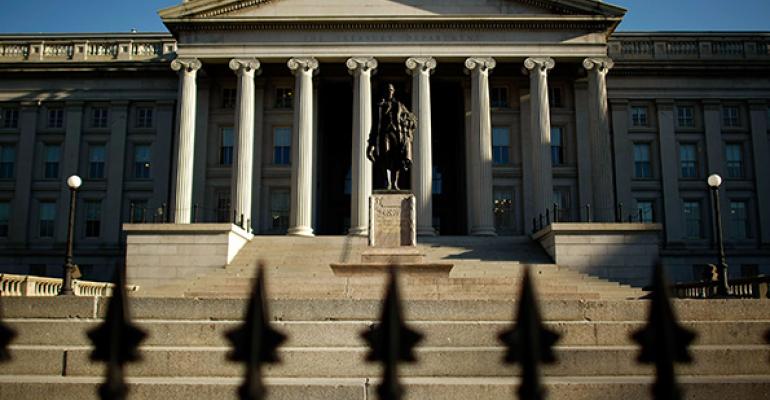By Alexandra Harris and Liz McCormick
(Bloomberg) --Get ready again for some wild fluctuations in the U.S. Treasury bill market. On March 16, the statutory limit on the nation’s debt, better known as the debt ceiling, will be reinstated.
Here’s a guide for what to watch for as the Treasury Department begins to resort to “extraordinary measures” in the coming days to continue to fund the government while meeting a legal requirement to limit the nation’s cash balance.
How Did We Get Here?
As part of a deal struck to avoid a default during a November 2015 political showdown, the Treasury will have to slice its operating balance to $23 billion by next week. That’s the amount when the compromise was reached by Congress in 2015 to avoid making the debt ceiling an issue again during the presidential election. Officials have already cut the cash by more than $200 billion since Feb. 10.

To meet the target, Treasury is trimming bill auction sizes, helping to keep bill yields from rising as fast as longer-maturity debt. Since Feb. 14, the four-week bill auction was slashed by $30 billion to $15 billion. The three- and six-month sales were reduced by $4 billion each on March 6. This means Treasury will pay down about $116 billion of bills during the next week, including $70 billion of cash-management bills, according to Thomas Simons, a senior economist at Jefferies LLC in New York. About $177 billion of bills have been retired since Dec. 1.
The efforts to reduce the cash balance, coupled with over $1 billion in increased demand from government-money-markets funds, a product of the Securities and Exchange Commission’s October 2016 reforms, has exacerbated a supply crunch in the bill market. Treasury securities maturing around the March 16 reinstatement are yielding nine to 10 basis points less than bills rolling off March 15 as investors fear being caught short of the securities. Debt that matures sooner usually trades at a higher price.
As a result, other short-term funding markets that trade off Treasury bill supply/demand dynamics are also seen as trading rich. The rate on overnight-repurchase agreements has been hovering around 53 basis points, just above the Federal Reserve’s 50 basis point target rate range floor, down from as high at 76 basis points earlier this year. The drop in repo rates relative to banks’ unsecured funds rates has driven the two-year swap spread -- the difference between the swap rates and similar maturity Treasury yields -- to near the widest level since May 2012.
What Happens Next?
The dislocations in money markets are expected to reverse quickly as the Treasury adds borrowing capacity after March 15 by using measures such as suspending contributions to government accounts and funds, halting the issuance of securities used by municipalities to help refund older debt and sales of saving bonds.
Bill auction sizes are likely to be increased as soon as Thursday for the three- and six-month sales occurring March 13 for March 16 settlement. Officials could raise as much as $120 billion in new cash in the bill sector in the 15 days after the March 15 reset, according to Lou Crandall, chief economist at Wrightson ICAP LLC in Jersey City, New Jersey.
The Congressional Budget Office has projected that the accounting maneuvers, combined with the typical inflow of tax receipts, should allow Treasury to finance the government’s normal operations for several months without an increase in the debt limit.
Drop-Dead Date
If Congress doesn’t lift the debt ceiling or suspend it again, the Treasury would probably run out of cash in the fall, the CBO estimated in a March 7 report. This hard debt-limit wall, as some call it, wouldn’t likely be faced until the end of September, according to Jefferies.
The re-infusion of bills is seen causing money markets to normalize. With more bills used as collateral, repo rates will rise and the gap over the Fed’s target floor will increase, helping to narrow swap spreads, predicts Michael Cloherty, the head of U.S. interest-rate strategy at RBC Capital Markets.
Bills will likely return to about the same percentage of total marketable government debt as before the supply cuts kicked in and then move higher, traders estimate. Treasury has focused in recent years on raising the percentage of bills from historic lows given growing demand.
Investors are closely watching Office of Management and Budget Director Mick Mulvaney to see whether he will fellow his predecessors’ leads and push to avoid a protracted debt-ceiling issue. The former congressman, who regularly voted against raising the federal borrowing limit in the past, may include discussions on the topic as Congress works to finish a spending package in April. Senate Majority Leader Mitch McConnell, speaking at event in Washington on Thursday, said “of course we raise the debt ceiling.”
“With the extra $1 trillion now in Treasury and government funds, it would be a colossal nuisance if we got to the point again where the debt ceiling became a real issue,” said Patricia A. Larkin, chief investment officer of cash investment strategies at Dreyfus Corp., which manages $145 billion in U.S. money-market fund assets. “We hope with the new administration that we don’t get there.”
--With assistance from Kathleen Hunter.To contact the reporters on this story: Alexandra Harris in New York at [email protected] ;Liz McCormick in New York at [email protected] To contact the editors responsible for this story: Boris Korby at [email protected] ;Jeremy Herron at [email protected] Dave Liedtka, Eric Weiner




